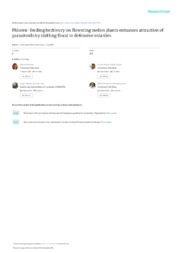Phloem-feeding herbivory on flowering melon plants enhances attraction of parasitoids by shifting floral to defensive volatiles.
Phloem-feeding herbivory on flowering melon plants enhances attraction of parasitoids by shifting floral to defensive volatiles.
Author(s): SILVEIRA, T. A.; SANCHES, P. A.; ZAZYCKI, L. C. F.; COSTA-LIMA, T. C. da; CABEZAS-GUERRERO, M. F.; FAVARIS, A. P.; GOULART, H. F.; BENTO, J. M. S.; SANTANA, A. E. G.
Summary: Emission of herbivore-induced plant volatiles (HIPVs) can differ according to the type of herbivory and the plant development stage, ultimately affecting recruitment of the natural enemy. Little is known about plant defenses induced at the flowering stage by phloem-feeding insects. We investigated the olfactory preference of Encarsia desantisi parasitoids and the chemical profile of flowering melon plants induced or not by the phloem-feeding of Bemisia tabaci whiteflies. In addition, we tested whether the parasitoids were attracted to synthetic defensive HIPVs, which mimicked whitefly-infested flowering melons. The parasitoids recognized volatiles from undamaged melons but preferred the scent of host-infested melons in olfactometry assays. Amounts of most individual volatiles did not differ between plant treatments; however, only whitefly-induced melons released methyl salicylate and tetradecane, compounds known to attract parasitoids. Interestingly, grouping volatiles by chemical classes revealed that whitefly-infested melon released larger amounts of monoterpenes and smaller amounts of benzenoids than undamaged melons, which might underlying the parasitoid attraction and indicate a possible trade-off between defensive and reproductive defenses at the melon flowering stage. Additionally, E. desantisi preferred the mix of synthetic and defensive HIPVs over hexane (control), opening a new avenue for further investigations in using olfactory lures for B. tabaci biological control. This study is the first report of induced defenses in melon plants and their mediation in a tritrophic interaction, as well as the first record of E. desantisi behavioral preference for HIPVs.
Publication year: 2018
Types of publication: Journal article
Unit: Embrapa Semi-arid Region
Observation
Some of Embrapa's publications are published as ePub files. To read them, use or download one of the following free software options to your computer or mobile device. Android: Google Play Books; IOS: iBooks; Windows and Linux: Calibre.
Access other publications
Access the Agricultural Research Database (BDPA) to consult Embrapa's full library collection and records.
Visit Embrapa Bookstore to purchase books and other publications sold by Embrapa.

